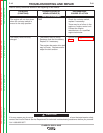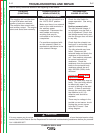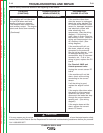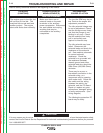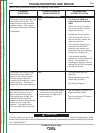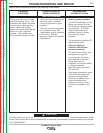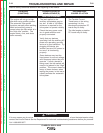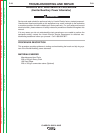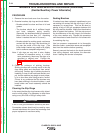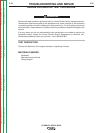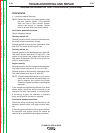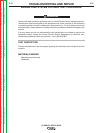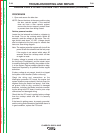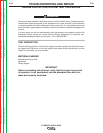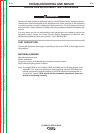
BRUSH & SLIP RING SERVICE PROCEDURE (continued)
(Exciter/Auxiliary Power Alternator)
TROUBLESHOOTING AND REPAIR
F-24 F-24
CLASSIC® 300D & 300G
PROCEDURE
1. Remove the round end cover from the exciter.
2. Examine brushes, slip rings and brush holder.
• Brushes should be clean and free of oil and
grease.
• The brushes should be of sufficient length
and have adequate spring tension.
(Generally, the brushes should be replaced if
either brush has less than 1/4” remaining
before it reaches the end of itʼs travel.)
• Brushes should be making good, continuous
contact with the slip rings, and should be rid-
ing near the center of the slip rings. (The
brush holder bracket may need to be slightly
bent to achieve acceptable alignment.)
Note: If slip rings are very dark in color, display
evidence of excessive arcing, or a have
worn prematurely, these may be signs of a
grounded or shorted rotor. Perform the
Exciter Rotor Resistance and Ground
Test.
3. Check for evidence of sticking brushes.
Sticking brushes will normally result in the slip
rings being pitted and discolored from exces-
sive arcing. Another sign of sticking brushes is
instability or loss of both weld and auxiliary out-
put, but the machine may begin to work proper-
ly for a short time after being jarred or moved.
If there is any evidence that the brushes may
have been sticking in the brush holders, a new
brush holder and brush assembly should be
installed.
Cleaning the Slip Rings
In the event that the slip rings become dirty, discol-
ored or mildly pitted, it is necessary to clean them
using a very fine 500 or 600 grit emery cloth.
A 220 or 320 grit commutator stone may be used.
Commutator stones should only be used by expe-
rienced technicians who have the knowledge and
proper equipment to use them safely.
Seating Brushes
If brushes have been replaced, repositioned or are
not making full contact with the slip rings, it will be
necessary to re-seat them. This can be done by
placing a strip of 180 grit sandpaper between the
slip rings and the brushes. Make sure the abrasive
side is against the brushes. Pull the strip around
the circumference of the slip rings in the direction
of the rotor rotation only. Repeat this procedure
until the surface of each brush is in full contact with
its matching slip ring.
Use low pressure compressed air to thoroughly
blow the carbon, commutator stone and sandpaper
dust from the machine before operating.
Securely connect the leads to the brush terminals
(see wiring diagram) and replace the alternator
cover if testing and service is complete.
CAUTION
Return to Section TOC Return to Section TOC Return to Section TOC Return to Section TOC
Return to Master TOC Return to Master TOC Return to Master TOC Return to Master TOC



